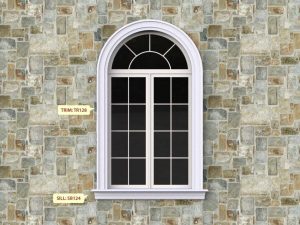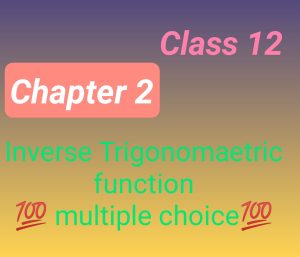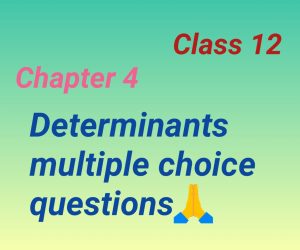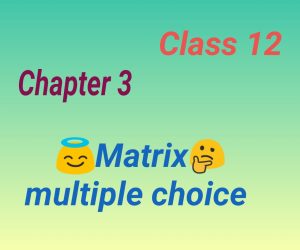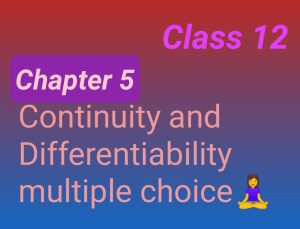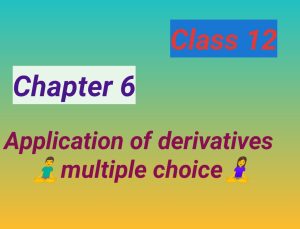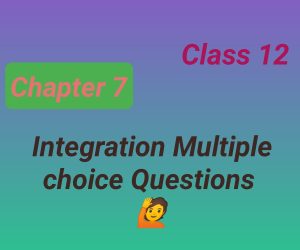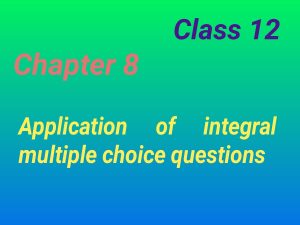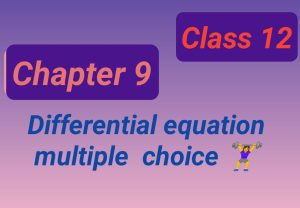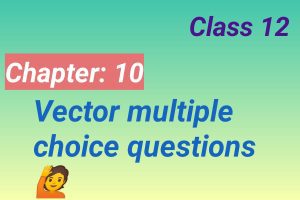Multiple Choice (Relation and Function)
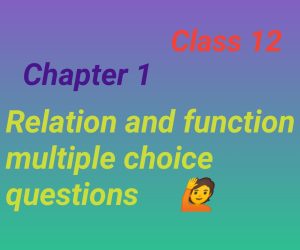
Question 1: A relation R in a set A is called _______, if ![]() implies
implies ![]() , for all
, for all ![]() .
.
(a) symmetric (b) transitive
(c) equivalence (d) non-symmetric
Answer: (a) symmetric
Explanation: A relation R in a set A is called symmetric, if ![]() implies
implies ![]() , for all
, for all ![]() ∈ A.
∈ A.
Question 2: Let R be a relation on the set N of natural numbers defined by aRb if a divides b. Then R is
(a) Reflexive and symmetric
(b) Transitive and symmetric
(c) Equivalence
(d) Reflexive, transitive but not symmetric
Answer: (d) Reflexive, transitive but not symmetric
Explanation: Given that a divides b, ∀ a ∈ N, R is reflexive.
Let a = 3 and b = 6
R is not symmetric since for 3, 6 ∈ N, 3 R 6 ≠ 6 R 3.
R is transitive since for (a,b)∈R and (b, c)∈ R
⇒ a devides b and b devides c
⇒ a devides c
⇒ (a, c) ∈ R
So, the given relation is reflexive, transitive, but not symmetric.
Question 3: The maximum number of equivalence relations on the set A = {1, 2, 3} are
(a) 1 (b) 2
(c) 3 (d) 5
Answer: (d) 5
Explanation: Given, set A = {1, 2, 3}
The equivalence relations for the given set are:
R1 = {(1, 1), (2, 2), (3, 3)}
R2 = {(1, 1), (2, 2), (3, 3), (1, 2), (2, 1)}
R3 = {(1, 1), (2, 2), (3, 3), (1, 3), (3, 1)}
R4 = {(1, 1), (2, 2), (3, 3), (2, 3), (3, 2)}
R5 = {(1, 2, 3) ⇔ A x A = A2}
Therefore, the maximum number of an equivalence relation is ‘5’.
Question 4: If set A contains 5 elements and the set B contains 6 elements, then the number of one-one and onto mappings from A to B is
(a) 720 (b) 120
(c) 0 (d) none of these
Answer: (c) 0
Explanation: Given, n(A) = 5
n(B) = 6
Each element in set B is assigned to only one element in set A for the one-one function.
Here, only ‘5’ elements of set B are assigned to ‘5’ elements of set ‘A’ and one element will be left in set B.
The range of the function must be equal to B. However, for the given sets, it is not possible.
Thus, the range of functions does not contain all ‘6’ elements of set ‘ B’. Therefore, if the function is one-one it cannot be onto.
Hence, the number of one-one and onto mappings from A to B is 0.
Question 5: Let f : [2, ∞) → R be the function defined by f(x) = x2 – 4x + 5, then the range of f is
(a) R (b) [1, ∞)
(c) [4, ∞) (d) [5, ∞)
Answer: (b) [1, ∞)
Explanation: Given, f : [2, ∞) → R
f(x) = x2 – 4x + 5
Let f(x) = y
x2 – 4x + 5 = y
⇒ x2 – 4x + 4 + 1 = y
⇒ (x – 2)2 + 1 = y
⇒ (x – 2)2 = y – 1
⇒ x – 2 = √(y – 1)
⇒ x = 2 + √(y – 1)
If the function is a real-valued function, then y – 1 ≥ 0
So, y ≥ 1.
Therefore, the range is [1, ∞).
Question 6: Let f : R → R be defined by f(x) = 1/x ∀ x ∈ R. Then f is
(a) one-one (b) onto
(c) bijective (d) f is not defined
Answer: (d) f is not defined
Explanation: f(x) = 1/x ∀ x ∈ R
Suppose x = 0, then f is not defined.
i.e. f(0) = 1/0 = undefined
So, the function f is not defined.
Question 7: Let A = {1, 2, 3} and consider the relation R = {1, 1), (2, 2), (3, 3), (1, 2), (2, 3), (1,3)}. Then R is
(a) reflexive but not symmetric
(b) reflexive but not transitive
(c) symmetric and transitive
(d) neither symmetric, nor transitive
Answer: (a) reflexive but not symmetric
Explanation: Given, A = {1, 2, 3}
R = {1, 1), (2, 2), (3, 3), (1, 2), (2, 3), (1, 3)}.
Let us write the combination of elements to check whether the given relation is reflexive, symmetric, and transitive.
R is reflexive because (1, 1),(2, 2),(3, 3) ∈ R.
R is not symmetric because (1, 2), (2, 3), (1, 3) ∈ R but (2, 1), (3, 2), (3, 1) ∉ R.
R is transitive because (1, 2) ∈ R and (2, 3) ∈ R ⇒ (1, 3) ∈ R
Therefore, R is reflexive, transitive, but not symmetric.
Question 8: Let f : R → R be defined by f(x) = x2 + 1. Then, pre-images of 17 and – 3, respectively, are
(a) φ, {4, – 4} (b) {3, – 3}, φ
(c) {4, –4}, φ (d) {4, – 4}, {2, – 2}
Answer: (c) {4, –4}, φ
Explanation: Given, f(x) = x2 + 1
f(x) = 17
x2 + 1 = 17
⇒ x2 = 16
⇒ x = ± 4
or ![]()
Again consider f(x) = – 3
⇒ x2 + 1 = – 3
⇒ x2 = – 4
So, ![]() φ.
φ.
Question 9: Set A has 3 elements, and set B has 4 elements. Then the number of injective mappings that can be defined from A to B is
(a) 144 (b) 12
(c) 24 (d) 64
Answer: (c) 24
Explanation: The total number of injective mappings from the set containing 3 elements into the set containing 4 elements is 4P3 = 4! = 4 × 3 × 2 × 1 = 24.
Question 10: Let A = {1, 2, 3}. Then the number of relations containing (1, 2) and (1, 3), which are reflexive and symmetric but not transitive is
(a) 1 (b) 2
(c) 3 (d) 4
Answer: (a) 1
Explanation: Relation R is reflexive as (1, 1), (2, 2), (3, 3) ∈ R.
Relation R is symmetric since (1, 2), (2, 1) ∈ R and (1, 3), (3, 1) ∈ R.
But relation R is not transitive as (3, 1), (1, 2) ∈ R but (3, 2)∉ R.
When we add any one of the two pairs, i.e. (3,2) and (2,3) or both, to relation R, it will become transitive.
Hence, the total number of desired relations is 1.
Question 11: Number of binary operations on the set {a, b} are
(a) 10 (b) 16
(c) 20 (d ) 8
Answer: (b) 16
Explanation: Let the given set be A = {a, b}
n(A) = 2
Total number of binary operations = 2(2 × Number of elements in the set)
= 2(2 × 2)
= 24
= 16
Therefore, the number of binary operations on the set {a, b} is 16.
Question 12: The Relation R in the set A ={1, 2, 3, 4} given by R = {(1, 2), (2, 2), (1, 1), )4, 4), (1, 3), (3, 3), (3, 2)} is.(Class 12 relation and functions multiple choice)
(a) Reflexive and Symmetric but not Transitive.
(b) Reaflexive and Transitive but not Symmetric
(c) Symmetric and Transitive but not reflexive
(d) An equivalence relation
Answer (b)
question 13: If A = {a, b, c, d}, Then a relation R ={(a, b), (b, a), (a, a)} on A is
(a) Symmetric only (b) Transitive only
(c) Reflexive and Transitive (d) Symmetric and Transitive only
Answer (d)
Question 14: For real number x and y, define xRy if and only if x – y + √2 is an irrational number. Then the relation R is
(a) Reflexive (b) Symmetric
(c) Transitive (d) None of these
Answer (a)
Question 15: Consider the non empty set consisting of children in a family and a relation R defined as aRb if a is brother of b. Then R is
(a) Symmetrict but not Transitive
(b) Transitive but not symmetric
(c) Neither symmetric nor transitive
(d) Both Symmetric and Transitive
Answer (b)
Question 16: The maximum number of equivalence relation on the set A = {1, 2, 3} are
(a) 1 (b) 2
(c) 3 (d) 5
Answer (d)
Question 17: Let L denotes the set of all straight lines in a plane . Let a relation R be defined by lRm if and only if l is perpendicular to m ∀ l,m ∈ L. Then R is
(a) Reflexive (b) Symmetric
(c) Transitive (d) None of these
Answer (b)
Question 18: Let A = {1, 2, 3}. Then number of relations containing (1, 2) and (1, 3) which are reflexive and Symmetric but not transitive is
(a) 1 (b) 2
(c) 3 (d) 4
Answer (a)
Question 19: Let A ={1, 2, 3}. Then number of equivalence relations containing (1, 2) is/are
(a) 1 (b) 2
(c) 3 (d) 4
Answer (b)
Question 20: Let A and B be finite sets containing m and n elements respectively. The number of relations that can be defined from A to B is
(a) ![]() (b)
(b) ![]()
(c) mn (d) 0
Answer (a)
Question 21: Set A has 3 elements and the set B has 4 elements. Then the number of injective mapping that can be defined from A to B is
(a) 144 (b) 12
(c) 24 (d) 64
Answer (c)
Question 22: The function f:R → R defined by ![]() is
is
(a) One-one and onto (b) Many one and onto
(b) One – one and onto (d) Many-one and onto
Answer (c)
Question 23: If the set A containing 5 elements and the set B contains 6 elements, then the number of one-one and onto from A to B is
(a) 720 (b) 120
(c) 0 (d) None of these
Answer (c)
Question 24: Which of the following functions from Z into Z is bijection?
(a) f(x) = x² (b) f(x) = x + 2
(c) f(x) = 2x + 1 (d) f(x) = x² + 1
Answer (b)
Question 25: Let f:[2, ∞) → R be the function defined by f(x) = x² -4x +5, then the range of f i24:
(a) R (b) [1, ∞)
(c) [4, ∞) (d) [5, ∞)
Answer (b)
Question 26: Let R be the relation defined on the set N of natural numbers by the rule xRy iff x +2y =8, then domain of R is
(a) {2, 4, 8} (b) {2, 4, 6}
(c) {2, 4, 6, 8} (d) {1, 2, 3, 4}
Answer (b)
Question 27: “Every relation is a function and every function is a relation “then which is correct for given statement ?
(a) True (b) False
(c) Can’t say anything (d) None of these
Answer (b)
Question 28: A = {x∈ R, -1 ≤ x ≤ 1} = B. The function f:A → B be given by f(x) = x|x| is
(a) Injective but not Surjective (b) Surjective but not injective
(c) Bijective (d) None of these
Answer (c)
Question 29: If a relation R on the set {1, 2, 3} be defined by R ={(1, 2)}, Then are is
(a) Reflexive (b) Transitive
(c) Symmetric (d) None of these
Answer (b)
Question 30: Let f:R → R defined by ![]() then f is
then f is
(a) One -one onto (b) one-one into
(c) many-one onto (d) many-one into
Answer (a)
Question 31: Let R be a relation on A = {a, b, c} such thet R= {(a, a), (b, b), (c, c)} then R is
(a) Reflexive (b) Symmetric only
(c) None Transitive (d) Equivalence
Answer (d)
